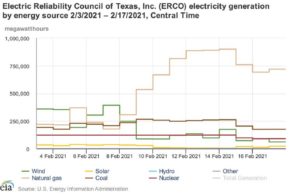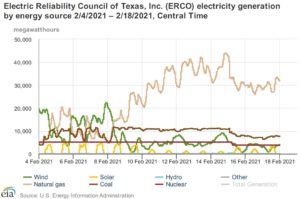by PBPA Staff
In early February, reports began to circulate that Texas was going to be hit by a severe winter weather event. Before the storm hit, the Electric Reliability Council of Texas (ERCOT) declared on February 8th that the event would “bring Texas the coldest weather we’ve experienced in decades.” At the depths of the storm, in the Permian Basin alone we not only saw single digit temperatures, but wind chills making it feel as cold as -11° F. But we don’t need to recite those temperatures to you. Each of you experienced the cold yourselves, and some more than others.
In the summer, you might hear the question, does the Texas grid have enough electricity to meet the demand during the hottest of days? Very rarely has that question been asked concerning power demand in the winter. However, in that February 8th release from ERCOT, the council was predicting a new winter peak demand could be set on Monday morning, February 15th. The previous record had been 65,915 megawatts (MW) set in January 2018. Why this should have caught everyone’s attention is that while Texas’ total winter capacity is about 83,000 MW including all power sources, total power generation at its peak is usually only around 57,000 MW. ERCOT was projecting we would exceed peak generation needs by nearly 10,000 MW during a time when freezing temperatures would likely cause disruptions in generation.
Leading into those projected peak demands, natural gas-fired plants produced 43,800 MW of power Sunday night (February 14), and coal plants added an additional 10,800 MW. This was about two to three times what these fuel sources usually generate at their peak on any given winter day. This increase in generation was desperately needed as certain other generation sources largely vanished due to the severe weather conditions. However, natural gas and coal, and other conventional power plants such as nuclear, could only hold up against the extreme weather for so long.
When temperatures around the state fell into the single digits early in the morning on Monday, February 15, some conventional power generation started to have problems, which unfortunately was the same time that power demand, particularly for heating, surged across the state. As Sunday turned into Monday and Tuesday morning arrived, natural gas-fired generation fell by about one-third from its high just a few days prior. Even with this fall, however, natural gas generation was still providing two to three times more power than it usually does during the winter. This is quite remarkable, in particular because natural gas was not much of the base power generation before the arctic storm, and during the storm gas plants were running low on fuel as pipelines in certain areas began to freeze.
How remarkable was it? According to data from the U.S. Energy Information Administration (EIA), between midnight on February 8 and February 16, natural gas powered generation increased by 450 percent.
PBPA began communicating with our membership in earnest on Thursday, February 11, updating those members on changing weather conditions, notices from regulatory agencies and the governor’s office, as well as learning from those members what they were seeing and experiencing in the field. From that point forward, PBPA was in nearly constant contact with members of our Electrical Coalition, Regulatory Practices Committee, and Health, Safety and Environment Committee.
As power demand grew around the state, producing facilities in the field became subject to rolling blackouts, causing even more natural gas to drop out of the equation. PBPA and its members quickly recognized that if these facilities could be re-energized, it would help decrease the need for such rolling blackouts around the state, benefiting those millions of residents in homes without heating.
Work with PBPA committees, along with the Railroad Commission of Texas, Public Utility Commission of Texas, and utility providers such as Oncor, TNMP, and AEP, helped get power to alleyways in the field, resulting in previously downed natural gas production coming back online and making it to power generation facilities. While Texas was in need of power and heat the most, the oil and natural gas industry of the Permian Basin responded, even while many were without power themselves or having to traverse iced-over roads in near sub-zero temperatures.
The staff of the PBPA is humbled by the response of our members and those in the Permian Basin. However, this isn’t the first time our members have gone above and beyond, and we know it won’t be the last. In hindsight for some, but not for those of us who appreciate their value, hydrocarbons as an energy source provide the reliable, efficient, and cost effective power that the residents of Texas not only deserve, but demand. We at the PBPA will continue to advocate for the development of natural resources in our region to ensure that our membership is doing everything that can be done to keep another extreme weather event like we experienced in February from crippling the State of Texas.









